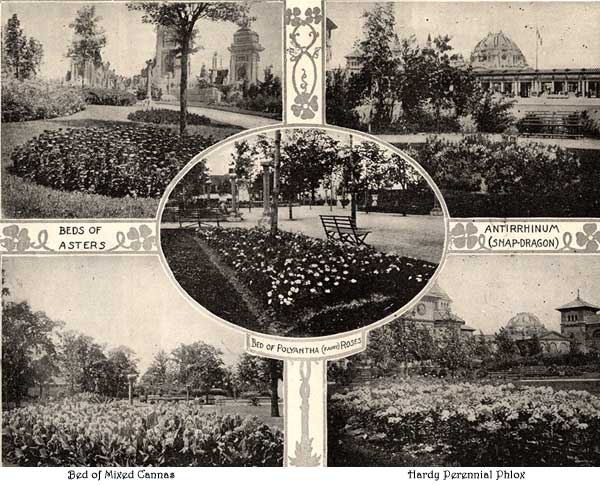Nearly every visitor to the Pan American Exposition at Buffalo considered the plant and flower display on the grounds one of the most attractive features of the Exposition. Many were the words of praise for the beautiful beds of bright blossoms and the perfect harmony of the whole arrangement, for not only were the blossoms of the several classes harmonious each with the other, but the whole effect harmonized with the color scheme of the buildings. To those familiar with plants, one of the chief beauties of the display at Buffalo was the simplicity of the arrangement as well as the fact that a large number of the plants used were of the old familiar classes, many of the finest displays being produced by the massing of so-called old-fashioned flowers, types familiar to the older generation, but which had been relegated to the background on the introduction of newer varieties in recent years. As it was the plan of the management in the Floral Department to keep the display at all times in the best possible condition, it was no easy task to have the plants in bloom and in good condition at the season when they were needed. It seems to the writer that the amateur who has had successful experience with the more easily grown classes of plants ought to feel encouraged by the fact that the display at Buffalo was composed so largely of the more common flowers and that it was possible to produce the effects that were produced by the use of the simple plants. No one can quarrel with those who are in a position to purchase and grow the newer varieties of plants, but it is certainly most satisfactory to feel that experts found it unnecessary to depend upon these newer kinds, but rather pinned their faith for desired results on the old tried sorts. The display of Asters in the late summer and fall was really remarkable, and these plants were used, as all plants of a similar nature should be used, entirely in masses. Beds twenty-five to fifty feet in diameter were composed entirely of Asters, the arrangement, of course, being artistic in the placing of the several colors. The old-fashioned, hardy perennial Phlox occupied prominent places on the Exposition grounds and attracted a great deal of attention, so much so that it is safe to say that many private gardens will be beautified with these magnificent flowers in coming seasons in spaces with have heretofore been devoted to the newer classes of plants. The old familiar Snapdragon was also used to great advantage, and its beauty as a bedding plant shown in a manner that must result in the extended planting of the class. It seems almost unnecessary to say that Cannas occupied considerable space on the Exposition grounds and so perfect was the arrangement of Canna beds that this tried class of plants will occupy more attention in the future on private grounds. The display of water plants and grasses created much favorable comment. The novice has supposed that the culture of aquatics was something needing the attention of skilled gardeners, but the aquatic displays certainly showed the possibilities of this class of plants on any home grounds where conditions were suited to their requirements. Early in the season the Rose display was one of the finest that has been seen in many years, the beds of Dwarf or Polyantha Roses being particularly striking. Some of these beds of Polyantha Roses were not located in the most favorable positions, but notwithstanding this they were decidedly attractive. There are few plants that will give more satisfaction to the amateur than Polyantha Roses. Of course, they require winter protection and in some sections considerable of it, but the floral result is will worth all the care necessary to keep them through the winter. The lesson the amateur may draw from the floral display at Buffalo is plain, for it has been clearly shown that satisfactory results in floral work by no means depend upon having in one's plant collection classes that are high in price or difficult to grow. It is safe to say that the principal cause of failure with beginners in plant culture comes from their anxiety to grow the more fashionable classes of plants, most of which require constant care and, in many cases, treatment peculiar to its class. The beauty of the older and more easily grown sorts is not less than that of the newer kinds and, in raising these, one has the satisfaction of obtaining results from the expenditure of time and money not possible with the other classes referred to except after years of experience in growing them. The work of a few seasons with the old garden favorites will fit the novice for the care of the more delicate plants, should one wish to add them to the collection.
|
